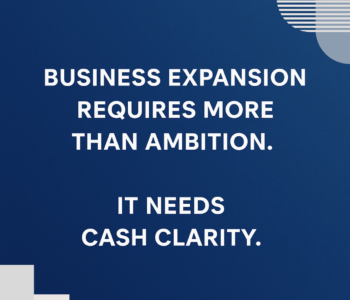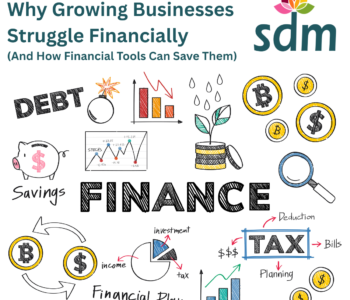
If You’re Profitable But Still Broke—Here’s Why
The Uncomfortable Truth About Cash Flow (and How to Fix It Before It’s Too Late)
The Wake-Up Call Most Business Owners Miss
You’re checking your revenue dashboard—it looks great.
Deals are closing. Invoices are out.
You feel good about where things are heading.
Then the calls start:
- A vendor reminds you about a past-due invoice
- Your finance team tells you salaries may have to be delayed
- The tax consultant flags an upcoming payment you forgot to provision
You suddenly realize:
“We look profitable on paper. But we’re cash poor in real life.”
This is the silent killer in businesses—especially for MSMEs and scaling companies. Let’s understand why.
SECTION 1: Cash Flow ≠ Profit — And That Mistake Can Sink You
Pain Point
Most founders obsess over profit but ignore cash. They assume profitability = sustainability.
In reality
- You may have invoiced ₹10L, but only received ₹4L
- You’re spending ahead of collections
- You don’t account for upcoming commitments like GST, TDS, EMIs
The Fix
Implement a Cash Flow Statement that tracks
- Opening balance
- Inflows (client payments, refunds, other income)
- Outflows (salaries, software, rent, taxes)
- Closing balance (what you actually have)
Make this a live dashboard, updated weekly.
You can survive a lack of profit. You can’t survive a lack of cash.
SECTION 2: Not Tracking the Flow = Bleeding Silently
Pain Point
You don’t know where the money is going—or leaking.
Common silent drains
- Unmonitored ad spends
- Unused tools & subscriptions
- Delayed collections from large clients
- Advance payments for projects that stall
The Fix
Classify your cash flow into three key buckets
- Operating Cash Flow – Day-to-day running of business
- Investing Cash Flow – Purchase of assets, upgrades
- Financing Cash Flow – Loans, repayments, investor draw
Review each category monthly. Ask:
- Is your operating cash flow positive?
- Are you investing ahead of earnings?
- Are you paying too much debt too soon?
SECTION 3: No Buffer = No Breathing Room
Pain Point
Your cash position is so tight that
- A late payment can stall salaries
- You miss early-payment discounts from vendors
- You panic instead of planning
The Fix
Build a 3-month cash reserve—a buffer for emergencies. Also,
- Create SOPs for receivable follow-ups (emails, auto-reminders, escalation)
- Offer early-payment incentives or partial advances
- Avoid overcommitting to long-term contracts without backup
- Cash flow isn’t about being rich—it’s about staying alive.
SECTION 4: Still Using Gut Feeling Over Data?
Pain Point
Business owners often rely on “instinct” instead of numbers. You ask,
- Can I hire this month?
- Can I invest in that new software?
- Can I take that big client project with 60-day terms?
But if you don’t see your projected inflows/outflows, you’re guessing
The Fix
Build a rolling 3- to 6-month cash flow forecast. It should answer –
- What happens if a client delays payment by 30 days?
- Can I handle a 20% dip in revenue next quarter?
- How much runway do I have if I don’t make another sale?
Forecasts help you anticipate, not just react.
REAL STORY: From Cash Crisis to Surplus
A ₹6 Cr SaaS company reached out in distress:
- Strong MRR and client base
- But just 40 days away from running out of cash
- Delayed receivables, unmonitored burn, no buffer
What we did:
- Implemented a real-time cash flow dashboard
- Created a 6-month forecast
- Built a receivable follow-up structure
- Established a working capital buffer
Outcome in 90 days:
- ₹18L recovered
- Salaries & vendor payments stabilized
- First cash surplus in over a year
- Zero panic during a seasonal revenue dip
SECTION 5: What Every Business Should Implement Today
To prevent cash flow disasters:
- Live Cash Flow Tracker → Update weekly; view real-time bank + receivable status
- Monthly Cash Flow Statement → Understand where cash is coming from and where it’s going
- 3-6 Month Forecast → Plan for taxes, EMIs, hiring, and seasonal shifts
- Receivable Management SOP → Avoid cash delays from slow-paying clients
- Quarterly Spend Review → Cut invisible expenses and redirect toward ROI-positive areas
WHERE CASH FLOW REPORTS ACTUALLY HELP YOU WIN
Most founders don’t know what to do with a cash flow report—here’s where it makes a difference.
- Strategic Planning
Use forecasts to decide when to scale, where to invest, and how to prepare for lean months.
Outcome: ✔️ You grow with control—without burning out cash. - Vendor & Client Negotiations
A clear report helps you spot payment trends, delays, and plan negotiation windows better.
Outcome:✔️ You negotiate better credit terms, avoid interest penalties, and never miss early payment discounts. - Hiring & Capacity Decisions
Know exactly when you can onboard new talent or contractors.
Outcome: ✔️ You avoid over-hiring and payroll crunches. - Investor & Board Confidence
Clean, consistent cash flow visuals build credibility with stakeholders.
Outcome: ✔️ You get faster approvals, more funding trust, and respect as a financially disciplined founder. - Crisis Prevention & Risk Planning
Spot upcoming crunches, delays in receivables, or months with negative inflow early.
Outcome: ✔️ You act before it becomes a cash emergency.
Add-On Tip: Build a simple Cash Flow Application Map for your team:
- Sales: Understand collections timing
- Ops: Know vendor due dates
- HR: Plan hiring based on surplus months
- Finance: Guide decisions using forecasts, not feelings
Final Word: Cash Flow Isn’t a Finance Task. It’s a Leadership Tool. Ignoring it is like running a marathon blindfolded.
- You don’t need to be a CFO
- You don’t need fancy software
- You just need structure, visibility, and discipline
Still relying on faith instead of financial facts? Start now. Or you’ll always be one late payment away from crisis.
Let’s Talk: If this blog made you rethink how you manage money—you’re already on the right path. Want help setting up real-time visibility for your business cash flow? Let’s build it together—before the next crunch.

